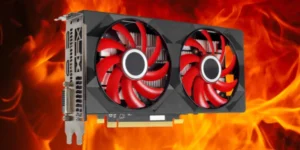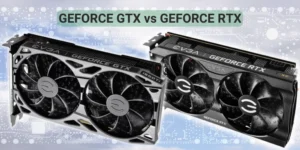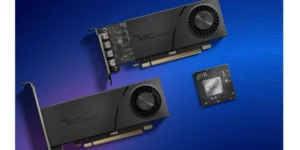Scalable Link Interface (SLI) is an NVIDIA multi-GPU technology that links two or more graphics cards to improve rendering performance. Similarly to NVIDIA, AMD introduced a multi-GPU technology called “Crossfire”. And in this article I will concentrate on SLI-related topics only.
Some people may wonder, is SLI worth it? Honestly, it’s not worthwhile so far. After January 2021, Nvidia will no longer adding new SLI driver profiles. And further, SLI is no longer widely supported by game developers. However, for enthusiasts, SLI can be one of the preferred options. This article may help you make better decisions.
Let’s get into more detail about this below.
- SLI Requirements
- Making the Most of SLI
- Compatibility of SLI Using Different Cards
- DirectX 12 API
- Is SLI Worth It?

SLI Requirements
The basic requirements for using SLI technology are as follows:
Compatible Motherboard
To take advance of SLI, you must have a motherboard that supports SLI technology. Such motherboards have enough PCIe x16 slots to support the number of graphics cards you intend to install and are specifically designed to support SLI configurations.
The spacing between the PCIe slots should also be large enough for setting up two or more graphics cards as required.
GPU chipset
To enable SLI, the graphics cards must be equipped with a SLI-certified GPU chipsets.
SLI only works when the GPU chipsets on the graphics cards is identical. The cards from different manufacturers are acceptable as long as the GPU chipsets is the same.
GPUs that support SLI functions can be from the GTX or RTX series. The following table lists some of these typical GPUs.
| GTX Series | RTX Series |
|---|---|
| GeForce GTX 1070 | GeForce RTX 2070 SUPER |
| GeForce GTX 1070 Ti | GeForce RTX 2080 |
| GeForce GTX 1080 | GeForce RTX 2080 SUPER |
| GeForce GTX 1080 Ti | GeForce RTX 2080 Ti |
| Nvidia Titan X | GeForce RTX 3090 |
| Nvidia Titan Xp | GeForce RTX 3090 Ti |
SLI Bridge
You will also need to look for an SLI bridge or SLI connector. While you can hypothetically run SLI with low-end graphics cards, it is recommended to use a connector if you can. In some cases, it is possible to use the chipset of your motherboard as a bridge.
Standard SLI bridges often come along with SLI compatible-motherboards.
Some graphics cards, depending on the manufacturer, can only support 2-way SLI (maximum 2 SLI-cards). These graphics cards have a single finger at the card’s end. Cards with dual fingers can support 3-way or 4-way SLI or more.
Selection of Power Supply Units (PSU)
When you increase the number of graphics cards running in your PC, you will need a sufficient power supply. Dealing with the extra GPU load is power-intensive. Modern graphics options and multi-GPU technology are costly.
You would also look at the manufacturer’s specifications to ensure that the PSU has enough power for the GPU and the rest of the system, as well as enough headroom for overclocking.
RELATED: How To Choose A PSU?
Computer Case and Cooling System
The computer case must be large enough to accommodate more graphics cards while also providing adequate ventilation and cooling. With a multi-GPU configuration, a liquid cooling custom system is a good option.
RELATED: Different Types of Liquid Cooling
Making the Most of SLI
Now that you have the necessary hardware and power to start using SLI, you will want to optimize the experience even more. Nvidia suggests you can achieve as much as a two-times performance boost using SLI technology with two graphics cards.
Further advancements from Nvidia regarding SLI include 3-way systems that hypothetically increase performance by as much as 2.8 times that of a single GPU.
Putting SLI into practice, there are two main modes of rendering used to make gaming smoother. Both SLI and CrossFire take advantage of Alternate Frame Rendering and Split Frame Rendering.
Alternate Frame Rendering (AFR)
Instead of one GPU handling the rendering work of all frames, they take turns. Rendering is simply alternating between one and the other card in rapid succession.
For example, we have two SLI-GPUs. Then GPU1 renders frame 1, GPU2 renders frame 2, and again GPU1 renders frame 3, and so on. The workload is distributed evenly among the GPUs when using this rendering mode.

Split Frame Rendering (SFR)
The NVIDIA driver divides the workload per frame into multiple regions and assigns each region’s workload to a different GPU.
For example, on a system with two SLI-GPUs, each frame can be split vertically into two regions (left and right). Then GPU 1 will render the left side of the frame, while GPU 2 will render the right side. The driver also automatically determines the workload of each region in order to adjust the division to ensure that all GPUs have the same workload.

Compatibility of SLI Using Different Cards
Now, we will talk about SLI compatibility. You cannot SLI two graphics cards together with different GPU chipsets.
Why? Well, because they do not work off the same instruction sets and architectures. There has to be some level of architecture commonality between GPUs to yield correct results when paired up in SLI mode.
And, as long as it’s the same GPU chipsets, you can SLI them with the lowest configuration (clock speed and VRAM) from one of the graphics cards. For example, card 01 has 2GB of VRAM and card 02 has 4GB of VRAM. When SLI is enabled, both graphics cards’ VRAM is set to 2GB.
With the advance of 3-way, 4-way or more SLI solution, the similarity of the GPUs chipset is even more stringent. While the potential performance benefits are immense compared to singular graphics cards, even small differences can create errors.
DirectX 12 API
SLI is a great advancement for using multiple graphics cards as one powerful unit. Significant advancements in gaming graphics and streaming information, on the other hand, can be difficult for game developers to integrate. Manufacturer’s drivers may be incapable of optimizing performance for various game applications.
Since its introduction, SLI has been managed by the display driver. Applications always treat the graphics devices as a single device, regardless of whether it is powered by a single GPU or multiple GPUs.
Microsoft announced DirectX 12 in 2014, and it was first included in Windows 10 in 2015. The DirectX 12 APIs allow developers to create their own graphics applications to handle GPUs. And that’s one of reason they announce on their official website:
NVIDIA will no longer be adding new SLI driver profiles on RTX 20 Series and earlier GPUs starting on January 1st, 2021.
With DirectX 12, developers will be able to handle and support multi-GPUs as well. This will maximize multi-GPU efficiency while avoiding common bugs when using drivers for various types of hardware configurations.
Is SLI Worth It?
Pros Of SLI
Performance
The most significant benefit of SLI is improved performance. With the SLI setting, frames per second (fps) scaling will double or more, making your video games much more vivid and realistic.
If you play games on multiple monitors, a multi-GPU with 2-way or 3-way SLI configuration is the best option because a single GPU could hardly handle that heavy workload.
If you have a high-resolution monitor with a high refresh rate, it necessitates a massive workload that a single GPU would struggle to handle. Then SLI will be the good choice to ensure that these requirements are met perfectly.
Cost effective
SLI allows you to improve performance by pairing two or more mid-range graphics cards. While a top-tier (expensive) card is unlikely to achieve such results.
Obviously, the cost-effectiveness of a multi-GPU SLI will make you consider when deciding to build your PC.
Cons of SLI
Compatibility
The advancement of 2-way, 3-way, 4-way, or more SLI solutions necessitates very strict GPU chipset similarity. Even minor differences can lead to driver bugs.
In fact, there are some cases where the driver fails to recognize the correct graphics card parameters in a SLI configuration. There have been several reports regarding these issues:
Application Support
As previously stated, with the release of DirectX 12, developers could be able to gain access to multi-GPU control. The manufacturer will no longer support new SLI driver profiles.
In fact, there are many games, the developers doesn’t support SLI. In this case, the rendering performance is equal to or worse than that of a single card. There is also the inconvenience of having to disable the SLI settings first when playing non-SLI games.
Micro Stuttering
The term “micro stuttering” refers to a common defect in frame delay when using multi-GPU technology. Where the frames instantaneous delay is frequently lower than what the benchmark requires. This causes the movement in video games to appear stuttering, resulting in a negative experience of the gamer.
You can refer to the actual experience of some gamers below.
- Tom’s Hardware: Micro-stuttering / hitch & Frametime spikes issue
- Tom’s Hardware: Micro Stutter in SLI all of a sudden?
Power-Hungry
We already know that graphics cards are one of the most power-hungry components. Using two or more graphics cards in your PC will put additional burden on the power supply.
To select a PSU with sufficient capacity, carefully review the manufacturer’s specifications. With a SLI setup, you’ll typically need a PSU that is at least 1000W or possibly much more, depending on the configuration.
Hot and Noise
Adding a graphics card will, of course, increase power consumption and thus generate more heat, and the fan spinning continuously. Your computer will be loud and hot. Installing a liquid cooling system is another viable option for you to consider.
SLI Verdict
So is SLI still worth it? You’re an enthusiast, and you may have your own reasons for continuing to pursue multi-GPU SLI configurations.
There is one issue that I must repeat because it is still worth mentioning. Particularly since SLI is no longer supported by a large number of games these days. Drivers for SLI profiles will no longer be included in future games. Developers may frequently coding multi-GPU applications without supporting SLI. So the advancement of this technology appears coming to an end.
In Conclusion
SLI rendering technology allows two or more identical GPUs to work together for double or more performance. You can still use SLI with different brands as long as the their GPU chipsets are identical.
SLI, in my opinion, is not a good choice for most gamers today. With today’s technology, you’d be better off investing in a single powerful GPU rather than a multi-GPU SLI configuration (or AMD’s Crossfire).
However, it is entirely up to you. Make a decision based on your research.





